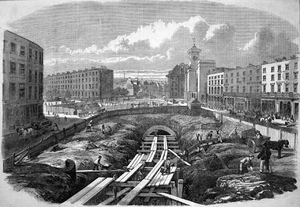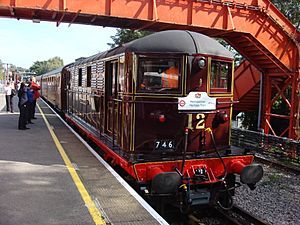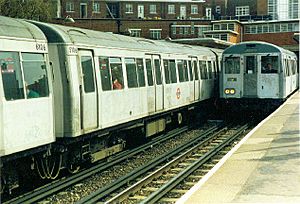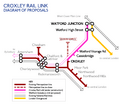Metropolitan line facts for kids
| Colour on map | Magenta |
| Year opened | 1863 |
| Line type | Sub-Surface |
| Rolling stock | S stock |
| Stations served | 34 |
| Length | 66.7 km (41.4 mi) |
| Depots | Neasden |
| Journeys made | 66.8 million (2011/12) |
The Metropolitan line is a famous part of the London Underground system. It's easy to spot on the Tube map because it's shown in a bright magenta (pinkish-purple) colour. This line made history! It was the very first underground railway in the world, opening way back on January 10, 1863.
Today, some parts of its original route are used by other lines, like the Hammersmith & City, District, and Circle lines. The main Metropolitan line travels from Aldgate in the heart of London all the way to Amersham. It also has branches that go to Uxbridge, Watford, and Chesham. The line used to go even further, to Verney junction, but its route was shortened over time.
The Metropolitan line runs next to the Chiltern Railways line from Finchley Road to Amersham. Chiltern Railways still offers train services to Aylesbury.
Contents
History of the Metropolitan Line
The First Underground Railway
The company that built this line was called the Metropolitan Railway, or just "the Met." It carried both people and goods in London from 1863 to 1933. Its main route went north-west from the City of London into what became the suburbs of Middlesex.
The very first section of the line connected major train stations like Paddington, Euston, and King's Cross to the City. Workers built much of it by digging a trench, building a tunnel, and then covering it up again. This method is called "cut-and-cover."
On January 10, 1863, the world's first underground railway opened. Its trains had wooden carriages lit by gas lamps and were pulled by steam locomotives. When Paris planned its own underground railway in 1871, they called it the Métropolitain, copying London's idea. The word "metro" that we use today comes from this French name.
Growing the Network
The Metropolitan Railway quickly grew. It extended its lines from both ends and added a branch from Baker Street going north. It reached Hammersmith in 1864 and Richmond in 1877. In 1884, it completed the Inner Circle route around central London.
But the most important growth was north into the countryside of Middlesex. This helped new towns and suburbs grow. The line reached Harrow in 1880. It eventually stretched over 50 miles (80 kilometres) from Baker Street to Verney Junction in Buckinghamshire. From the late 1800s, the Metropolitan Railway shared tracks with the Great Central Railway line from Marylebone station.
Modernising the Trains
In 1905, the railway started using electric trains. These trains ran between Uxbridge, Harrow-on-the-Hill, and Baker Street. To get rid of smoke and steam in the central London tunnels, the railway bought electric locomotives. From 1908, these electric engines pulled trains through the tunnels. At Harrow, they would swap with steam locomotives for the journey further out.
In 1910, a silent film was made showing much of the journey from Baker Street to Aylesbury and Uxbridge. You could see the view from the train's front. This film still exists today and you can watch it!
Unlike other railways, the Met also developed land for houses. This meant the railway made money from the land's value increasing because of the new train line. After World War I, they even promoted their housing areas near the railway with a special name: "Metro-land."
To make services better, the railway bought stronger electric and steam locomotives in the 1920s. A short new branch line opened from Rickmansworth to Watford in 1925. After World War I, a 4-mile (6.4 km) branch was built from Wembley Park to Stanmore.
Becoming Part of London Transport
On July 1, 1933, the Metropolitan Railway joined other underground railways, tram companies, and bus operators. They all became part of the London Passenger Transport Board (LPTB). This led to many changes.
The Metropolitan Railway used to run long-distance services with steam trains and even carried goods. But the LPTB wanted to focus on electric trains and serving the suburbs. So, goods services were given to another railway company. All services north-west of Aylesbury were stopped by 1936.
The 1930s saw London's north-western suburbs grow very fast. The LPTB made big plans to improve the Metropolitan line. Several stations on the Uxbridge branch were rebuilt with modern designs. Uxbridge station even got a new location in the town centre.
A busy part of the line was the double-track tunnel from Baker Street to Finchley Road. To fix this, two new tube tunnels were dug underneath the Metropolitan tunnels. Slower trains and the Stanmore branch were moved to the Bakerloo line. (This route later moved to the Jubilee line in 1979.) In 1936, the line was extended east from Whitechapel to Barking.
The LPTB also got many different types of electric trains from the old railway. They updated these trains to create a single, standard fleet. In the 1950s, F Stock trains were moved from the District line. These trains mostly ran the faster services to Harrow and Uxbridge.
Post-War Changes
A big plan to rebuild the main line from Wembley Park to Amersham was delayed by World War II. After the war, the line from Wembley to Harrow was rebuilt. The whole project finished between 1956 and 1962. Until 1961, passenger trains still used steam locomotives from Rickmansworth to Aylesbury.
The rebuilding project electrified the line from Rickmansworth to Amersham. This meant all Aylesbury services were given to British Railways. By 1962, a pair of fast tracks were added from Harrow to north of Moor Park. This allowed outer-suburban trains to run quickly to Moor Park.
New A stock trains, which were originally unpainted aluminium, replaced the older trains. More A Stock trains were built in 1962–63 for the Uxbridge service. This meant the main line used only one type of train. A Stock trains were made of 4-car units. They usually ran as eight-car trains, but a 4-car unit ran the Chesham shuttle service. In 1986, trains started to be operated by just one person, the driver.
A Unique Identity
The East London line was shown as part of the Metropolitan line on maps until 1968. By 1990, the Hammersmith & City line became its own separate line. This meant the Metropolitan line ran from Aldgate to Baker Street and then north to Amersham. It kept its branches to Chesham, Uxbridge, and Watford.
In 2003, the railway's infrastructure was partly privatised. A group called Metronet managed it. But Metronet ran into problems in 2007. Transport for London (TfL) then took over responsibility. Later, TfL also bought Tube Lines in 2011.
On December 12, 2010, the service to Amersham was reduced. A direct service between Chesham and central London was introduced. The last passenger services using the old A Stock trains ran on September 26, 2012. A special public train tour happened on September 29.
Images for kids
See also
 In Spanish: Metropolitan Line para niños
In Spanish: Metropolitan Line para niños










